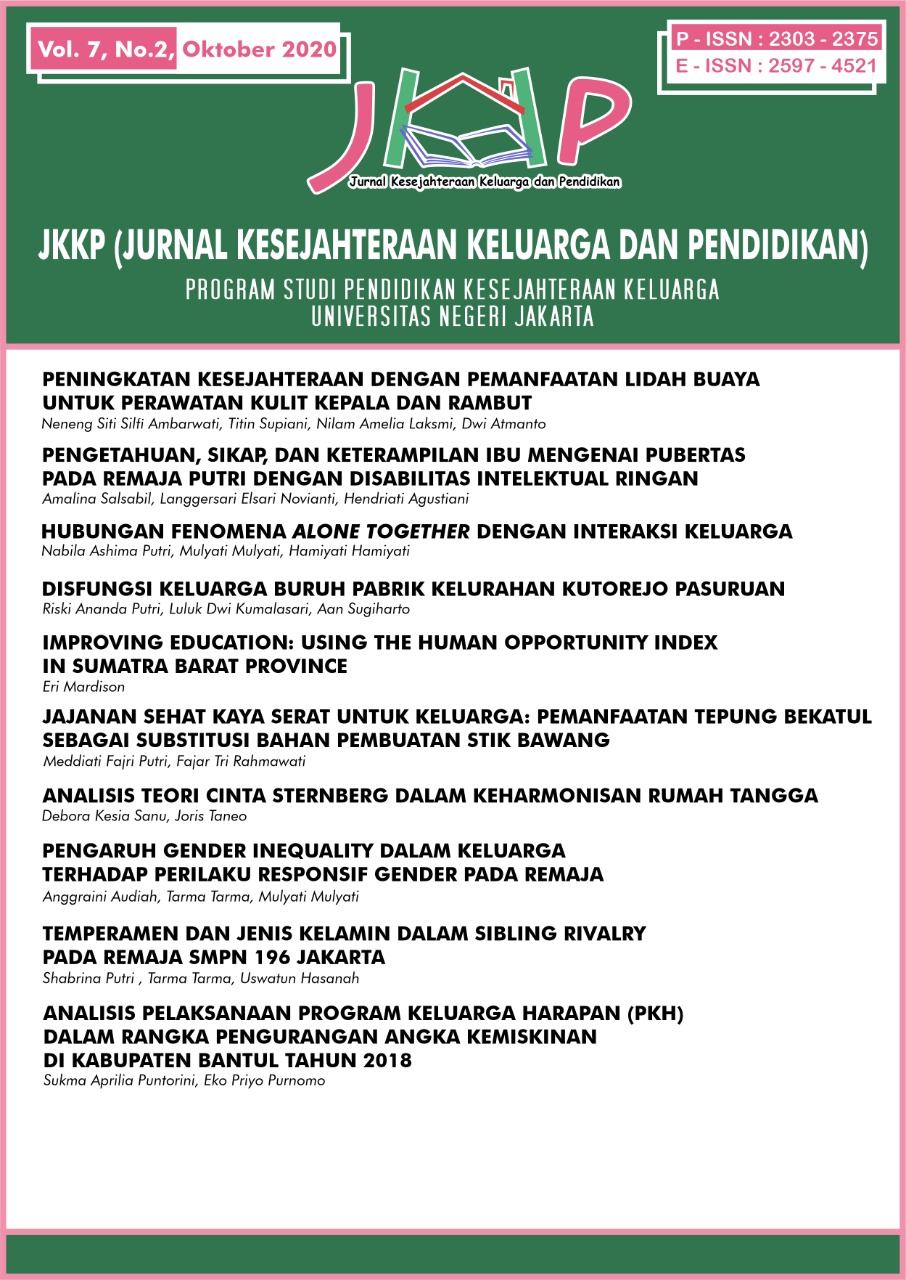IMPROVING EDUCATION: USING THE HUMAN OPPORTUNITY INDEX IN SUMATRA BARAT PROVINCE
DOI:
https://doi.org/10.21009/JKKP.072.05Keywords:
education, equality, HOI, Sumatera BaratAbstract
Factors such as gender, location of residence, number of family members, the household head sex, the work status of the household head, the education of the household head, and the income per capita of the household head. Even though this condition is not their choice. The HOI’s results show how much inequality is due to these factors in achieving school participation in 2019 in Sumatra Barat Province. At the preschool level, the new coverage reaches 49.45 percent, which is still around 8.28 percent of opportunities for education that need to be reallocated to ensure equality in 2019. At the elementary and junior high school levels the coverage has reached 98.47 percent, reallocation of opportunities for education that is necessary reallocated to ensure equality in 2019 only 0.43 percent. While at the SMA level, coverage has reached 83.63 percent and opportunities for education that need to be reallocated to ensure equality in 2019 are still 4.50 percent. These results indicate that preschool has not been the priority level in general. The magnitude of the dissimilarity at this level is dominated by the factor i.e; the diploma of household head and per capita income, while other factors can be ignored because it is not significant in logistic regression. At the SD and SMP levels, location of residence and sex of children are factors that influence inequality, while other factors can be ignored. At the SMA level, more factors have a significant effect i.e; the sex of the child, the location of residence, the sex of the household head and the diploma of the household head. Increasing equality of opportunity is one way of providing justice to children in West Sumatra. Knowledge of the contributing factors is a very appropriate way to solve educational problems. In turn, this will be one of the factors to spur increased school coverage.
Abstrak
Faktor-faktor seperti jenis kelamin, tempat tinggal, jumlah anggota keluarga, jenis kelamin kepala rumah tangga, status pekerjaan kepala rumah tangga, pendidikan kepala rumah tangga, dan pendapatan perkapita kepala rumah tangga. Padahal kondisi ini bukanlah pilihan mereka. Hasil HOI menunjukkan seberapa besar ketimpangan yang disebabkan oleh faktor-faktor tersebut dalam pencapaian partisipasi sekolah tahun 2019 di Provinsi Sumatera Barat. Di tingkat prasekolah, cakupan baru mencapai 49,45 persen, yang masih sekitar 8,28 persen dari peluang pendidikan yang perlu dialokasikan untuk memastikan pemerataan di tahun 2019. Di tingkat SD dan SMP cakupannya sudah mencapai 98,47 persen, realokasi Peluang pendidikan yang perlu dialokasikan kembali untuk menjamin pemerataan pada 2019 hanya 0,43 persen. Sedangkan di tingkat SMA, cakupannya sudah mencapai 83,63 persen dan peluang pendidikan yang perlu dialokasikan kembali untuk memastikan pemerataan di tahun 2019 masih 4,50 persen. Hasil ini menunjukkan bahwa prasekolah belum menjadi tingkat prioritas secara umum. Besarnya ketidaksamaan pada level ini didominasi oleh faktor yaitu; ijazah kepala rumah tangga dan pendapatan perkapita, sedangkan faktor lain dapat diabaikan. Pada tingkat SD dan SMP, lokasi tempat tinggal dan jenis kelamin anak merupakan faktor yang mempengaruhi ketimpangan, sedangkan faktor lainnya dapat diabaikan. Di tingkat SMA, lebih banyak faktor yang berpengaruh signifikan yaitu; jenis kelamin anak, tempat tinggal, jenis kelamin kepala rumah tangga dan ijazah kepala rumah tangga. Meningkatkan kesetaraan kesempatan merupakan salah satu cara untuk memberikan keadilan kepada anak di Sumatera Barat. Pengetahuan tentang faktor-faktor penyebabnya merupakan cara yang sangat tepat untuk menyelesaikan masalah pendidikan. Pada gilirannya, ini akan menjadi salah satu faktor pendorong peningkatan cakupan sekolah.
Kata kunci: IKM, kesetaraan, pendidikan, Sumatera Barat
Downloads
Published
Issue
Section
License
Authors who publish with this Journal agree to the following terms:
- Author retain copyright and grant the journal right of first publication with the work simultaneously licensed under a creative commons attribution licensethat allow others to share the work within an acknowledgement of the work’s authorship and initial publication of this journal.
- Authors are able to enter into separate, additional contractual arrangementfor the non-exclusive distribution of the journal’s published version of the work (e.g. acknowledgement of its initial publication in this journal).
- Authors are permitted and encouraged to post their work online(e.g. in institutional repositories or on their websites) prior to and during the submission process, as it can lead to productive exchanges, as well as earlier and greater citation of published works.
Users/public use of this website will be licensed to CC BY SA
![]()







